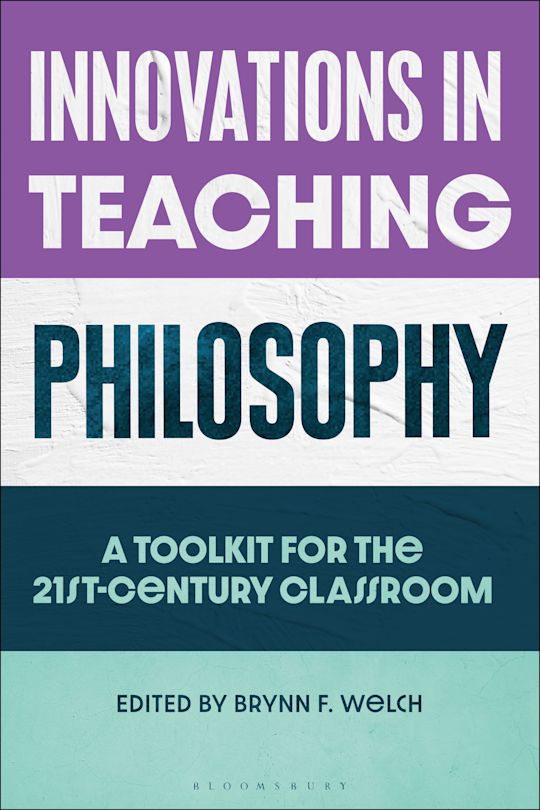Innovations in Teaching Philosophy
A Toolkit for the 21st-Century Classroom
- Textbook
Innovations in Teaching Philosophy
A Toolkit for the 21st-Century Classroom
- Textbook
Description
What am I doing here, and what do I want this class to be? What kind of class am I designing, and why? What does a meaningfully inclusive classroom look like? Innovations in Teaching Philosophy tackles the current challenges in higher education with bite-size chapters offering practical advice on a variety of issues.
Here you will find guidance from award-winning teachers about what they have tried in the classroom, how it worked, and why they did it. Motivated by a recognition of the ever-changing landscape philosophy teachers face, the conversational tone of the short chapters emphasize accessibility and practicality. Standalone chapters allow you to gravitate toward what worries or inspires you the most.
The focus throughout is on the most pressing features of the current teaching environment: the role of technology and the desire to make classrooms more inclusive. Contributors encourage and make space for building a community, rethinking who teachers and students are and what a philosophy class can and should look like. A final section written exclusively by students considers the wonders and woes of the various styles of teaching they have encountered.
This essential companion is packed with tried and tested tools ready to be modified and adopted to suit your goals as an instructor. Here is a chance to better understand what you want for your course, for the students and for the immensely rewarding experience of teaching philosophy.
Table of Contents
List of Tables
Acknowledgments
Introduction, by Brynn F. Welch
Part I: Teaching with Purpose
1. “Good Enough” Pedagogy, by Emily Lange, Abram Capone, and Claire Lockard
2. Rethinking Backwards Design and Learning Outcomes, by Rebecca Scott
3. Learning to Fail, by Joanna Lawson and Christopher Blake-Turner
4. Thinking about Doing Rather than Telling: The Purpose of Philosophy via Experiential Learning, by Madeline Ahmed Cronin
5. Philosophy in the K-12 Philosophy and College Classroom, by Claire Katz
6. Welcoming “The Animal”: Including Other-than-Humans in the Philosophy Classroom, by Karen S. Emmerman
7. Teaching for the Process of Learning, by Renée J. Smith
Part II: Community in the Classroom
8. Philosophy and Intersectionality, by Anwar Uhuru
9. Integrative Pedagogy is Inclusive Pedagogy, by Becky Vartabedien
10. Story Time: On Making Sense and Nurturing Empathy in the Philosophy Classroom, by Carlos Alberto Sánchez
11. I Don't Have the Guts for This: How Losing Twenty Percent of My Small Intestine Changed My Teaching, by John Wolfe
12. Taming In-Class Participation: How to Use Participation to Foster Belonging and Deep Philosophical Engagement in the Classroom, by Aliosha Barranco Lopez
13. The Socratic Method Reclaimed and Reformed, by Heather Anne Phillips
14. Neuro-Inclusive Pedagogy in Philosophy Classrooms, by Amelia Hicks and JayJay Mudridge
15. From Accommodation to Access: Decentering Ableism and Respectability Culture in the Classroom, by Quill R Kukla
Part III: Expanding the Teaching Toolkit
16. AI in the Classroom: Friend, Foe, or Forget About It? by John Basl and Vance Ricks
17. Reading Together: Using Perusall to Help Students Learn How to Engage with Readings, by K. Lindsey Chambers
18. Using Packback to Bring Back the Fun of Discussion Boards, by Brynn F. Welch
19. Using Audio and Video Feedback on Student Writing, by Julia Staffel
20. Applying Ethics: Engaging with Virtual Reality, by Lauren Traczykowski
21. Just Ask Them! by Danielle (Dani) Clevenger
22. Teaching Critical Thinking with Directional Analysis, by Teresa Kouri Kissel
23. Mitigating Misconceptions about Hypotheticals, by David O'Brien
24. Philosophy Goes to Couples Therapy: A Tool for Teaching Ethical Dialogue, by Joshua May
25. Whose Argument is it Anyway: Integrating Improv Games into the Philosophy Classroom, by Russell Marcus, Nathalie Martinez, and Ashley Pryor
26. Expanding our Pedagogical Toolbox: Using Personas to Achieve Course Goals, by Andrew P. Mills, Monica “Mo” Janzen, and Sarah K. Donovan
Part IV: Teaching in Motion
27. Mentoring the First Big Project: Two Pages at a Time, by Karen Adkins
28. When Computers Crash and Dogs Eat Your Homework: Teaching Students to Rewrite from Scratch, by Barbara Cohn
29. Virtuous Dialogues in Epistemic Communities: Helping Students Understand the Value of Citations, by Cassie Finley and Kristopher G. Phillips
30. Readiness Testing in the Philosophy Classroom, by Dustin Locke
31. Failing in Front of Your Peers: A New Pedagogy of Logic, by Sara L. Uckelman
32. A Plea for More Collaborative Student Assignments, by Candice Delmas
33. Students Need Need: Against inert-and towards catalyzing-dialogue and presentations, by Stephen Bloch-Schulman and Ann J. Cahill
34. Curiosity and Creative Conversations: Meeting Students Where They Are, by W. John Koolage
Part V: Student Reflections
35. Reflections from a Non-Traditional Student, by Amy Soulis
36. The Role of Students in Teaching Philosophy, by Nadira Jeethandran
37. Navigating Discussions of Identity, by Jordan Price
38. Students Are Philosophers If You Invite Them To Be, by Aiyana Race
39. Graduate Students are Educators, Too, by Henry C. Curcio
Part VI: Making It Count
40. Making the Case for the Value of Teaching Through Self-Authorship: From “What Does the Discipline Want of Me?” to “Who Do I Want to Be?”, by Stephen Bloch-Schulman
Notes on Contributors
Index
Product details

| Published | 11 Dec 2025 |
|---|---|
| Format | Ebook (PDF) |
| Edition | 1st |
| Extent | 376 |
| ISBN | 9781350544864 |
| Imprint | Bloomsbury Academic |
| Publisher | Bloomsbury Publishing |

ONLINE RESOURCES
Bloomsbury Collections
This book is available on Bloomsbury Collections where your library has access.























